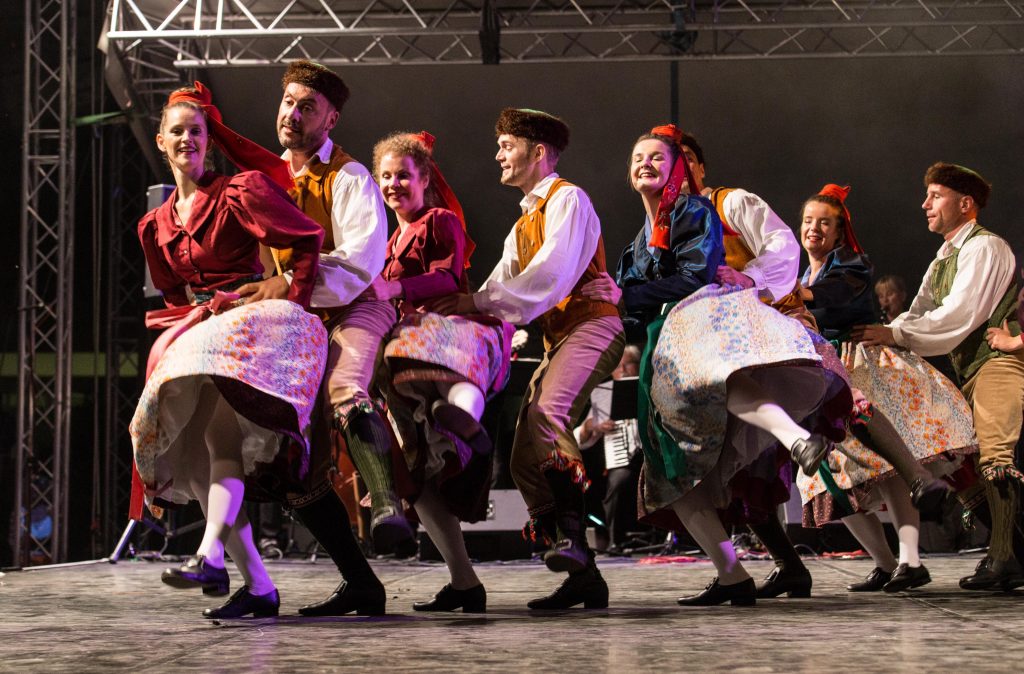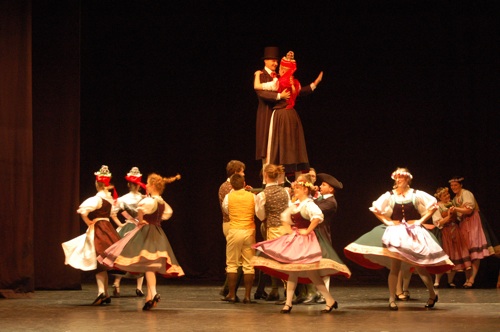Dances of the Current Season

Lichtertanz (Candle dance)
Choreography: Thea Maass
Celebratory dance by 12 dancers who dance with burning candles on their heads.

Orakel frage (Ask the Oracle)
Choreography: Thea Maass
The custom of asking oracles comes from Thuringia. In spring, the girls throw their self-made wreaths into a stream or pond and hope to see the face of their loved one in it. Nobody is actually allowed to disturb them. But the young boys naturally try to sneak up on them …

Niedersorbische Freite (Lower Sorbian Courtship)
Choreography: Bernhardt Wossin
This courtship dance comes from the Lower Sorbian region of Lusatia. The girls are under the special care of a man for a whole year. This man accompanies them to all the festivals throughout the year.
A special feature of the dance is that the girls have to keep their gaze lowered during the entire first part of the dance and still portray their liveliness and feelings for the men.

Rühler Springer (The Jumpers of Ruhla)
Choreography: Thea Maass
This energetic dance originates from the Thuringian village of Ruhla and clearly shows the vitality of its inhabitants at the time. The men jumped up so vigorously that it could be heard for miles around.
Incidentally, the music for this dance is said to have been written by the young Johann Sebastian Bach.
Winzertanz (Dance of the Winemakers)
Choreography: Aenne Goldschmidt
This cheerful dance is based on various forms of the Rhinelander. Various stages of wine production in the Lößnitz, Germany’s northernmost wine-growing region, are depicted in dance.
For example, the pressing of the grapes, the tasting of the wine and what might happen when one tastes too much wine.

Varsovienne (from Warsaw)
Choreography: Aenne Goldschmidt / Thea Maass
This dance, which originated in Poland, is a form of the Warsaw dance, but is now danced throughout Germany. Its special feature is the constant alternation between powerful mazurka steps and atmospheric waltz forms.
Our Varsovienne is based in Pomerania and is danced in a traditional Weizack costume.
Ländlicher Walzer (the Rural Waltz)
Choreography: Aenne Goldschmidt
The waltz is often referred to as the national dance of the Germans. Its cradle is said to have been in Swabia, which prompted the dance researcher R. Voß to say in his book “Der Tanz und seine Geschichte!” in 1869: “The invention of the waltz is one of the ‘most endearing Swabian antics’”.
In our Rural Waltz we show various waltz forms from all over Germany, which are danced with great intimacy. The traditional costume of Betzingen is to be worn in this choreography work.
Hütejungen (Herding Boys)
Choreography: Günter Neubert
In times gone by, shepherds or herdboys spent many hours alone with their animals on the pasture. To pass the time, they tried out all sorts of tricks with their shepherd’s sticks, putting their temperament and playfulness to the test.
Four spirited Thuringian herding boys meet and try to outdo each other with their tricks.

Dreisteyrer
Choreography: Thea Maass
This choreography is based on Styrian twirling forms from Bavaria and Austria for one boy and two girls. The skill here lies in not releasing the hands during the various twirling figures. The male dancer tries to conquer both girls at the same time and then has to live with the “consequence”.
Alte Polka (Old Polka)
Choreography: Rosemarie Elm-Schulz
A young couple in Mecklenburg forgets about their work in the fields when they are having fun and dancing.

Wer zuerst am Maibaum ist … (Whoever gets to the maypole first …)
Choreography: Maud Butter
In the Altmark region, a race was held in spring for girls to reach a birch tree decorated with ribbons and scarves. The winner receives the scarves, which are also great for dancing.
Wenn im Herbst die Trauben reifen – Pfälzer Suite (When the grapes ripen in fall – Palatinate Suite)
Choreography: Thea Maass
This choreography is considered a masterpiece of folkloristic stage dance. It shows typical dances, games and customs from the wine-growing region of the Palatinate.
The girls proudly demonstrate in the “glass dance” that can be danced very well with a full wine glass on their head without spilling a single drop. The boys demonstrate their skill, strength and courage in the high-spirited “chair dance”.

Am Pfingstbrunnen (At the Pentecost Fountain)
Choreography: Maud Butter
In this choreography, we present old customs from Saxony-Anhalt that serve to care for the fountain with its vital water. Young men and women clean and decorate their well at Pentecost. Every year, one boy dresses up as a frog, the symbol of fertility.
Of course, the girls all want to dance with him to find out who is under the mask this year.
Other Dances from Our Repertoire
Neckmazurka (Teasing Mazurka)
Choreography: Thea Maass
“Those who tease each other, love each other” … or dance together.
Mazurka forms from all regions of Germany are used in the choreography.

Webertanz (Weaver Dance)
Choreography: Aenne Goldschmidt
The weaver’s dance originated in northern Germany and is also documented in Sweden. It depicts the work processes of rural hand weaving in a masterly dance-like manner. The weaving frame, the spindles, the plaid weaving and the weaving of the shuttle can all be seen. At the end, the woven fabric is tested for strength and rolled into a bale.

Gaben zur Hochzeit (Gifts for the Wedding)
Choreography: Maud Butter
The choreography represents the gift-giving part of a peasant wedding. In addition to their purely material value, which was necessary for the newly established household, wedding gifts always had a symbolic meaning.
The kunkel or distaff was intended to encourage the bride to spin diligently and thus perfect her household.
The bale of cloth and the traditional custom of wrapping the bride and groom in it served to symbolize fertility in a rather drastic way. The bride and groom were often laid on the bridal bed wrapped up like this and then left to their own devices!
Attaching as many baby clothes as possible to the dancing bride was intended to determine the number of children the bride and groom were expecting.
In addition to their purely practical significance, cake boards were also used to decorate the house or kitchen. The dancing of the bride and groom on it was intended to bind the couple closely together.






